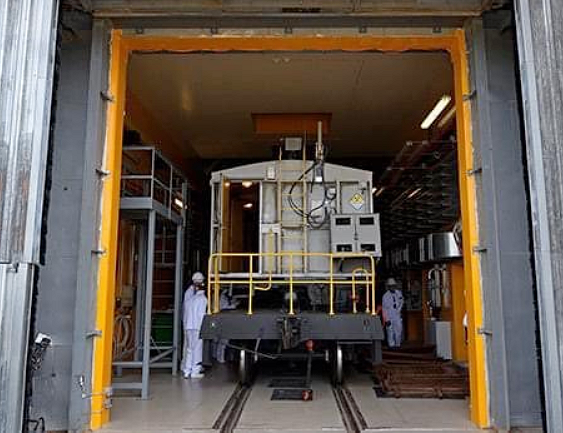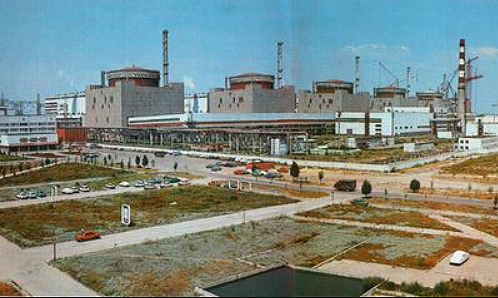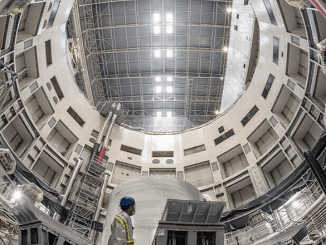
VIENNA, Austria, March 11, 2022 (ENS) – Ukraine’s nuclear regulator lost all communications with the Chernobyl Nuclear Power Plant, the disaster site where radioactive spent fuel is stored, on Monday, the day after the Russian-controlled facility lost all external power supply, International Atomic Energy Agency Director General Rafael Mariano Grossi told reporters calmly.
Grossi made this disclosure at a news conference Monday upon his return to Vienna after his talks with the foreign ministers of Ukraine and the Russian Federation – Dmytro Kuleba and Sergei Lavrov in Antalya, Turkey.

There is no landline or mobile phone communication with staff at the Chernobyl site, and road and rail travel to the site is blocked. Director General Grossi said that the agency is aware of reports that power has now been restored to the site and is seeking confirmation.
Earlier Monday, the Ukraine regulatory authority, the State Nuclear Regulatory Inspectorate of Ukraine had told the IAEA that emergency diesel generators were providing electricity to the Chernobyl NPP.
But the subsequent loss of communication means that the regulator can no longer provide updated information about the Chernobyl site to the IAEA.
According to the information received before the loss of communication, both of the site’s power lines had been damaged, in effect disconnecting it from the grid, Ukraine’s regulatory authority said.
To ensure continued power, these lines would either need to be repaired or the generators holding fuel for two days would require additional diesel deliveries.
The diesel generators were powering systems important for safety, including those for spent nuclear fuel and water control and chemical water treatment, the State Nuclear Regulatory Inspectorate, SNRIU, said. At this time, the operator is not able to maintain some functions at Chernobyl such as radiation monitoring, ventilation systems, and normal lighting.
Chernobyl Still Dangerous 36 Years Later
The world’s worst nuclear accident both in cost and casualties occurred on April 26, 1986 at the No. 4 reactor in the Chernobyl Nuclear Power Plant, near the city of Pripyat in the north of the Ukrainian SSR in the Soviet Union. The explosion and fire there sent a radioactive cloud across Europe.
The USSR built the protective Chernobyl Nuclear Power Plant sarcophagus by December 1986, which reduced the spread of radioactivity from the ruins and protected it from weathering. It also provided radiological protection for the crews of the undamaged reactors at the site, which were restarted in late 1986 and 1987.
Due to the continued deterioration of the sarcophagus, it was further enclosed in 2017 by the $2 billion Chernobyl New Safe Confinement. This larger enclosure allows the removal of both the sarcophagus and the reactor debris remotely, while containing the radioactive hazard.

Used fuel from units 1–3 was stored in the units’ cooling ponds, and in an interim spent fuel storage facility pond, ISF-1, which now holds most of the spent fuel from units 1–3. Fifty of the fuel assemblies from units 1 and 2 were damaged and required special handling. Moving fuel to ISF-1 was thus carried out in three stages, completed in June 2016.
A need for larger, longer-term radioactive waste management at Chernobyl is to be fulfilled by a new facility designated ISF-2. This facility is to serve as dry storage for used fuel assemblies from units 1–3 and other operational wastes, as well as material from decommissioning units 1–3.
Nuclear clean-up at Chernobyl is scheduled for completion in 2065.
Power Loss at Chernobyl Not An Emergency, But…
The IAEA reports that the present disconnection of Chernobyl from the grid “will not have a critical impact on essential safety functions at the site, where various radioactive waste management facilities are located, as the volume of cooling water in the spent fuel facility is sufficient to maintain heat removal without a supply of electricity.”
The regulator further confirmed this assessment, stating that the safety analysis report for the site’s spent fuel storage facility concluded that there would be “no impact on essential safety systems” in the case of a total loss of power, including electricity provided by emergency sources such as diesel generators.
And, the operator has also been able to confirm that there are no damages in the structures and systems of the spent fuel storage pool, and their original functions are maintained.
If emergency power was also to be lost, SNRIU, the regulatory agency, said it would still be possible for staff to monitor the water level and temperature of the spent fuel pool. But they would carry out this work under worsening radiation safety conditions due to a lack of ventilation at the facility. They would also not be able to follow operational radiation safety procedures, SNRIU said.
“When water temperature in the cooling pool reaches 40 °С because of intensive evaporation, this will lead to conditions in which instrumentation may fail and it will be very complicated for the personnel to take measures to control potential emergencies and accidents. The radiological situation at ISF-1 will also significantly deteriorate and the personnel will be subjected to additional doses,” the Ukrainian regulator SNRIU warned.
Director General Grossi has expressed alarm about the deteriorating and exhausting conditions for staff at the Chernobyl NPP, who have not been able to rotate since the day before Russian forces took control on February 24.
He has said this is also compromising a vital safety pillar, which states that “operating staff must be able to fulfil their safety and security duties and have the capacity to make decisions free of undue pressure.”
Further adding to the stressful situation is the total loss of communication. The site had earlier been able to communicate with the regulator by email.

Regarding the status of Ukraine’s operational nuclear power plants, SNRIU said eight of the country’s 15 reactors remained operating, including two at the Zaporizhzhya Nuclear Power Plant, three at Rivne, one at Khmelnytskyy, and two at South Ukraine. Radiation levels at the four sites were normal, the regulator said.
The Zaporizhzhya NPP site power supply situation is unchanged from that reported by the IAEA on March 9. The site has four high voltage (750 kV) offsite power lines plus an additional one on standby. Two of the four have been damaged and so currently there are two power lines, plus the one on standby. The operator informed the IAEA that the NPP off-site power needs could be provided with one power line available. Diesel generators are ready and functional to provide back-up power.
However, in another challenge for the Zaporizhzhya NPP, it is not currently possible to deliver necessary spare parts, equipment and specialized personnel to the site to carry out planned repairs, and maintenance activities at Unit 1 have been reduced to the minimum level required by the plant operational procedures.
The IAEA is in contact with Ukraine authorities regarding radiation monitoring systems in Ukraine.
IAEA Loses Remote Data Transmission From Nuclear Safeguards Systems
In another development, Director General Grossi said the IAEA had lost remote data transmission from its safeguards systems installed to monitor nuclear material at the Chernobyl NPP and the Zaporizhzhya NPP. He said he was concerned about the sudden interruption of such data flows to the IAEA’s Vienna headquarters from the two sites, where large amounts of nuclear material are present in the form of spent or fresh nuclear fuel and other types of nuclear material.
The reason for the disruption in the transmission of safeguards data was not immediately clear. The IAEA continues to receive such data from other nuclear facilities in Ukraine, including the three other nuclear power plants.
“The remote transmission of data from IAEA safeguards equipment located at nuclear sites around the world is an important component of our safeguards implementation, in Ukraine and globally,” Grossi said. “Such systems are installed in several facilities in Ukraine, including all nuclear power plants, and enable us to monitor nuclear material and activities at these sites when our inspectors are not present.”
The IAEA has not yet been able to re-establish communication with those installed safeguards data monitoring systems.
European Bank for Reconstruction and Development Sounds the Alarm
The European Bank for Reconstruction and Development, EBRD, is “extremely concerned” by recent developments at the Chernobyl Nuclear Power Plant in Ukraine.
The EBRD, which has been managing over €2.5 billion in international funds to transform Chernobyl since 1995, believes that recent events are putting in jeopardy the achievements of decades of successful international collaboration to secure the site.
The Bank’s position on ChNPP is fully aligned with that of the International Atomic Energy Agency and is based on the following safety and security considerations:
- Uninterrupted power supply must be maintained for the Chernobyl facilities. Any loss of power is potentially a serious threat to their nuclear safety.
- Since monitoring and control systems on site do not work, operators will not be aware of possible risks. They must stay in operation.
- The Chernobyl facilities have been operated by the same depleted shift of employees for more than two weeks. Normal shift rotation as well as supplies to operating staff must be ensured.
- Any military action on site is extremely dangerous for the old spent fuel storage facility housing around 20000 RBMK fuel assemblies.
- Inspections by the Ukrainian regulator and the IAEA must be allowed.
- Beyond Chernobyl, there are 15 VVER-type units across Ukraine. They have a relatively weak containment and will not withstand a direct hit, which may result in irreversible consequences.
“Transforming Chernobyl was a long-term challenge. Through the EBRD-managed funds the international community, together with Ukraine, has managed to transform Chernobyl into an environmentally safe and secure site,” the EBRD said in a statement today.
“It has created the foundations to develop and implement a national nuclear safety strategy for the coming decades,” the bank stated. “The ongoing war must not be allowed to ruin these achievements.”
Featured image: The Chernobyl Safe Containment structure was assembled in sections near the damaged reactor and slid into place on rails. Completion of containment was achieved in 2017. (Photo courtesy European Bank for Reconstruction and Development)



